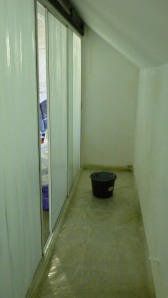Stig at Cupboard Love – installation/performance. Greyfriars Studios, Lincoln
We were approached by Nick Simpson to perform in an event at Greyfriars during an evening of videos and happenings in the Studio’s cupboards, cubbyholes and small spaces.
The two spaces that chose were opposite each other in the corridor approaching the studio space. Both cupboards had glass doors, they felt like animal enclosures; the long cupboard, containment of a creature pacing back and forth, the smaller one something more static.
Taking the space as the lead and introducing our ideas about contemporary conditioning and the denatured instinct, containment and resistance, the lived and the inscribed body under surveillance, we began developing Stig.
The work would revolve around being stuck, locked in by contemporary forces that attempt to normalise what Foucault refers to as “delinquent bodies”.
Erving Goffman defined stigma as ‘the process by which the reaction of others spoils normal identity’; as a special kind of gap between virtual social identity and actual social identity:
stigma from PIE *st(e)ig- (see stick (v.)) The French sociologist Émile Durkheim was the first to explore Stigma as a social phenomenon in 1895. He wrote:
Imagine a society of saints, a perfect cloister of exemplary individuals. Crimes or deviance, properly so-called, will there be unknown; but faults, which appear venial (forgivable) to the layman, will there create the same scandal that the ordinary offense does in ordinary consciousnesses. If then, this society has the power to judge and punish, it will define these acts as criminal (or deviant) and will treat them as such. (Durkheim, 1895).
Stig also recognises that resistance is not straightforward, that desires embody complex pushes and pulls, at times the urge is to forge ahead and at others times to remain static. Mud would be an exemplary material analogy here, to pace back and forth in it in the long cupboard and to be fairly static and stuck in it in the smaller cupboard.
stick-in-the-mud (n.) – 1733, from stick (v.) on notion of “to stick in the mud, to be content to remain in an abject condition.”
The term ‘stick-in-the-mud’ would appear to be a less than sympathetic colloquial term for what is now referred to learned helplessness or conditioned defeat which describes an internal pattern that results from being trained to be locked into a system. The system may be a family, a community, a culture, a tradition, a profession or an institution.
Initially, a system develops for a specific purpose. But as a system evolves, it increasingly tends to organise around beliefs, perspectives, activities and taboos that serve the continuation of the system. Awareness of the original purpose fades and the system starts to function automatically. It calcifies. The beliefs, perspectives, activities and taboos shift in subtle (and sometimes not so subtle) ways, to ensure continuation. And those beliefs, perspectives, activities and taboos are trained into the people that comprise the system.
We wanted the pacing to be only partly visible – just the feet in mud. Painting the majority of the glass with lime wash on the inside and leaving a narrow strip at the base – the piece had a painterly look, almost a reference to Rothko with accompanying existential angst perhaps.
The gothic arched cupboard would contain a figure with a huge heavy knot of roots on her head, feet buried in mud and crowned in her uprootedness.
The work gave us a very clear opportunity to extend our individual practices and allow us to stretch beyond our comfort zones so that our roles continue to become more fluid and less fixed.




